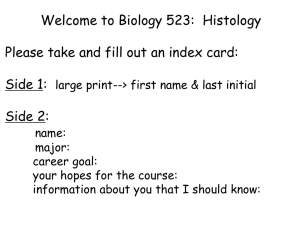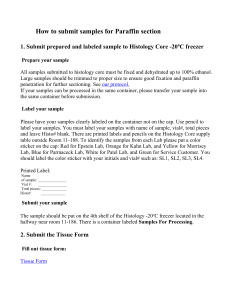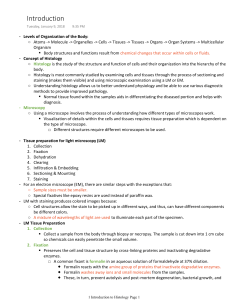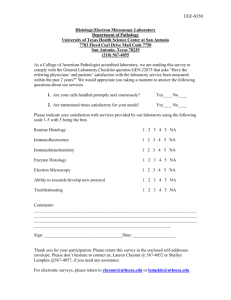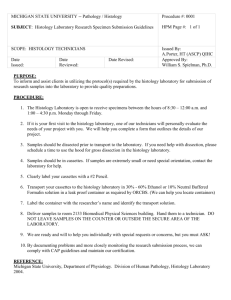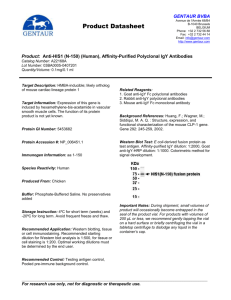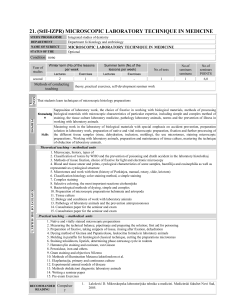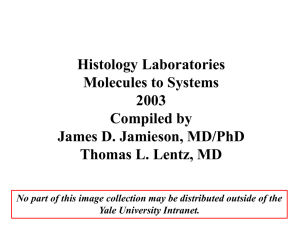Submit adult samples for paraffin section
advertisement
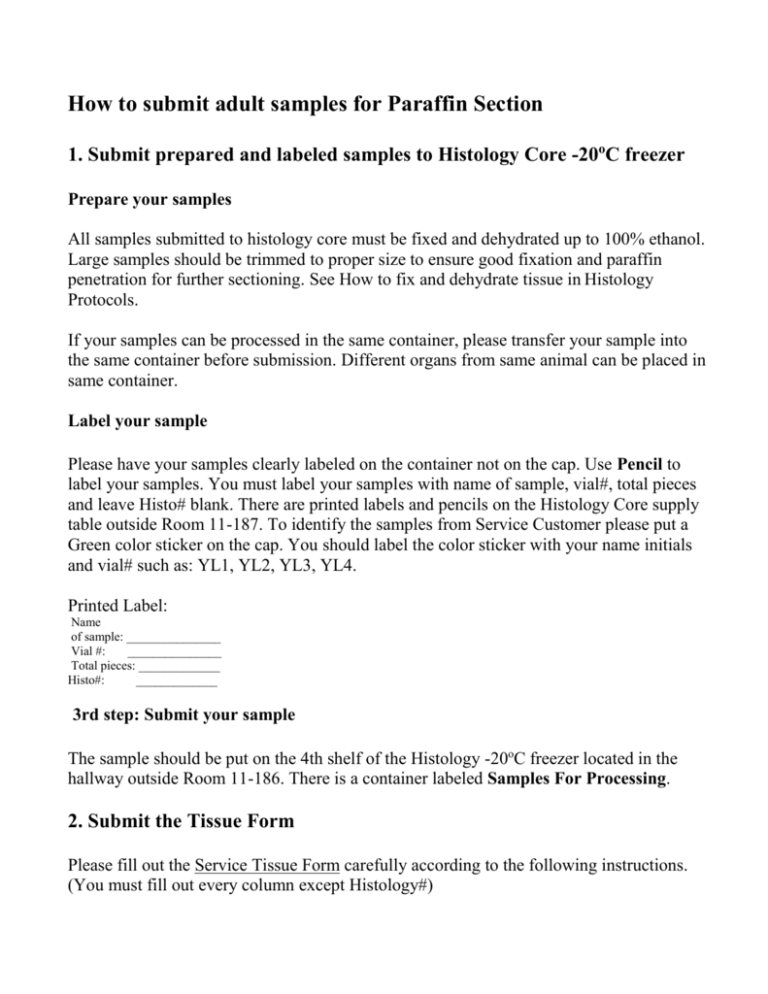
How to submit adult samples for Paraffin Section 1. Submit prepared and labeled samples to Histology Core -20oC freezer Prepare your samples All samples submitted to histology core must be fixed and dehydrated up to 100% ethanol. Large samples should be trimmed to proper size to ensure good fixation and paraffin penetration for further sectioning. See How to fix and dehydrate tissue in Histology Protocols. If your samples can be processed in the same container, please transfer your sample into the same container before submission. Different organs from same animal can be placed in same container. Label your sample Please have your samples clearly labeled on the container not on the cap. Use Pencil to label your samples. You must label your samples with name of sample, vial#, total pieces and leave Histo# blank. There are printed labels and pencils on the Histology Core supply table outside Room 11-187. To identify the samples from Service Customer please put a Green color sticker on the cap. You should label the color sticker with your name initials and vial# such as: YL1, YL2, YL3, YL4. Printed Label: Name of sample: _______________ Vial #: _______________ Total pieces: _____________ Histo#: _____________ 3rd step: Submit your sample The sample should be put on the 4th shelf of the Histology -20oC freezer located in the hallway outside Room 11-186. There is a container labeled Samples For Processing. 2. Submit the Tissue Form Please fill out the Service Tissue Form carefully according to the following instructions. (You must fill out every column except Histology#) Histology#: Leave it blank. Name of Sample: Use the following format and abbreviations for this column * For wild type mice. Write: CD1, Black 6, etc. * For transgenic mice. Write: 1. Gene name; 2. Tg; 3. Mut or WT; * For knock out mice. Write: 1. Gene name; 2. KO; 3. -/-, +/- or +/+. For example, Wnt7B KO -/-, Wnt7B KO +/+. * For multiple genotypes. Write: 1. Gene name / gene name; 2. -/-, +/- or +/+. For example, Ch16del/P3proCre +/-. Vial #: You should label the vial with your initials such as: YL1, YL2, YL3, YL4. Age: Write adult first then age ( Adult 2 M) Organ & Pieces: Write the name of each organ or tissue. Write the total number of pieces in each vial. For example: heart x3. You don't need indicate one piece. Section Orientation & Interested Area: Orientation: Write Cross, Sagittal, Frontal or maximal area only. Do not use other term. . Interested Area: You must specify in detail the area that you are interested. For example: Heart: you should write atrium, ventricle or whole heart, from outflow tract (OF) to middle of ventricle. Artery: aorta, aortic arch, dorsal aorta. # of sets, # of slides: # of sets will have adjacent sections on each slide. For example, 8 sets means you will have the slides to do 8 different staining on adjacent sections. # of slides will obtain a number of desired slides with sections in consecutive order. Please see explanation of # of sets & # of slides. Generally, 8-12 sets will be used for sets. Tissue or organs will be sectioned 10 sets. There will be one or two sections on each slide. Multiple organs or the same kind of organ with different genotypes will be on same slide. Staining HE, Eosin, IHC, InSitu: HE staining is a routine staining for general cell morphology. (HE is Hematoxylin and Eosin staining. Hematoxylin is used for nuclear staining and nuclei show blue staining. Eosin is used for cytoplasmic staining and cytoplasm show pink staining.) Use Light Eosin for Beta-gal counter-stain IHC (Immunocytochemistry) In Situ (In Situ Hybridization) Group samples in same block: Several individual samples can be embedded in same block or sectioned on same slide. You can separate them from next group by leave a blank row on the form. Sample form: Molecular Cardiology Service Center Service Request Form Date: 3-07-11 Department: CVI Phone#: 746-4413 Fixative: 4% PF Lab Name: Tom Cappola Contact name: Yan Li Email: yanli2@mail.med.upenn.edu Fixation Time: O/N Sample in Solution 100% ETOH Project Name: The Role of FOX Repressors in Heart Failure Brief Description of the Experiment: (include name of tissue and total number of tissue) We will test if there is any histology change in the adult heart after heart specific Foxp1 and Foxp4 double KO by Tamoxifen inducible MerCre mouse. Histology # (Leave Blank) Name of Sample Vial # Age 1. CD-1 or black 6 2. Gene KO +/+,-/3. Gene Tg Mut, WT 4. Gene/Gene +/+ MerCre7851 YL29 3M Organ & Pieces Heart 1 Section Orientation & Interested Area cross # of Sets or # of Slides 8 sets Staning HE, Eosin IHC, InSitu H+E immune inSitu MerCre7855 YL30 3M Heart 1 cross 8 sets Foxp1:p4Mer7841 YL31 3M Heart 1 cross 8 sets Foxp1:p4Mer7845 YL32 5M Heart 1 cross 8 sets MerCre7852 YL33 5M Heart 1 cross 8 sets H+E immune inSitu H+E immune inSitu H+E immune inSitu H+E immune inSitu Send the Tissue Form as attachment to: lancheng@mail.med.upenn.edu Write “Service Tissue Form” on the e-mail subject line. The weekly sample submission deadline is Wednesday You should submit tissue and tissue form on Wednesday. Generally your samples will be processed the first week (starting from Thursday) and sectioned the second or third week. You will be informed if there are questions regarding your sample submission. You may need to come to our core on Thursday morning to check if your samples and forms are all correct. If the samples are not prepared as required or the form is filled not correctly, the samples will not be processed. You will receive an E-mail with attached Tissue Form when the sections are done. You should bring your slides box to our core to get the slides. Your blocks will be returned at same time.
